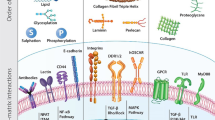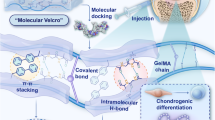Abstract
Bioactive polymeric scaffolds are a prerequisite for the ultimate formation of functional tissues. Here, we show that supramolecular polymers based on quadruple hydrogen bonding ureido-pyrimidinone (UPy) moieties are eminently suitable for producing such bioactive materials owing to their low-temperature processability, favourable degradation and biocompatible behaviour. Particularly, the reversible nature of the hydrogen bonds allows for a modular approach to gaining control over cellular behaviour and activity both in vitro and in vivo. Bioactive materials are obtained by simply mixing UPy-functionalized polymers with UPy-modified biomolecules. Low-molecular-weight bis-UPy-oligocaprolactones with cell adhesion promoting UPy-Gly-Arg-Gly-Asp-Ser (UPy-GRGDS) and the synergistic UPy-Pro-His-Ser-Arg-Asn (UPy-PHSRN) peptide sequences are synthesized and studied. The in vitro results indicate strong and specific cell binding of fibroblasts to the UPy-functionalized bioactive materials containing both UPy-peptides. An even more striking effect is seen in vivo where the formation of single giant cells at the interface between bioactive material and tissue is triggered.
This is a preview of subscription content, access via your institution
Access options
Subscribe to this journal
Receive 12 print issues and online access
$259.00 per year
only $21.58 per issue
Buy this article
- Purchase on Springer Link
- Instant access to full article PDF
Prices may be subject to local taxes which are calculated during checkout





Similar content being viewed by others
References
Griffith, L. G. & Naughton, G. Tissue engineering – current challenges and expanding opportunities. Science 295, 1009–1014 (2002).
Hench, L. L. & Polak, J. M. Third-generation biomedical materials. Science 295, 1014–1017 (2002).
Hirano, Y. & Mooney, D. J. Peptide and protein presenting materials for tissue engineering. Adv. Mater. 16, 17–25 (2004).
Clark, E. A. & Brugge, J. S. Integrins and signal transduction pathways: the road taken. Science 268, 233–239 (1995).
Stupack, D. G. & Cheresh, D. A. Get a ligand, get a life: integrins, signaling and cell survival. J. Cell Sci. 115, 3729–3738 (2002).
Hersel, U., Dahmen, C. & Kessler, H. RGD modified polymers: biomaterials for stimulated cell adhesion and beyond. Biomaterials 24, 4385–4415 (2003).
Pierschbacher, M. D. & Ruoslahti, E. Cell attachment activity of fibronectin can be duplicated by small synthetic fragments of the molecule. Nature 309, 30–33 (1984).
Massia, S. P. & Hubbell, J. A. An RGD spacing of 440 nm is sufficient for integrin αvβ3-mediated fibroblast spreading and 140 nm for focal contact and stress fiber formation. J. Cell. Biol. 114, 1089–1100 (1991).
Ruoslahti, E. RGD and other recognition sequences for integrins. Annu. Rev. Cell Dev. Biol. 12, 697–715 (1996).
Aota, S. -I., Nomizu, M. & Yamada, K. M. The short amino acid sequence Pro-His-Ser-Arg-Asn in human fibronectin enhances cell-adhesive function. J. Biol. Chem. 269, 24756–24761 (1994).
Leahy, D. J., Aukhil, I. & Erickson, H. P. 2.0 Å crystal structure of a four-domain segment of human fibronectin encompassing the RGD loop and synergy region. Cell 84, 155–164 (1996).
Feng, Y. & Mrksich, M. The synergy peptide PHSRN and the adhesion peptide RGD mediate cell adhesion through a common mechanism. Biochemistry 43, 15811–15821 (2004).
Kokkoli, E., Ochsenhirt, S. E. & Tirrell, M. Collective and single-molecule interactions of α5β1 integrins. Langmuir 20, 2397–2404 (2004).
Mardilovich, A. & Kokkoli, E. Biomimetic peptide-amphiphiles for functional biomaterials: the role of GRGDSP and PHSRN. Biomacromolecules 5, 950–957 (2004).
Maynard, H. D., Okada, S. Y. & Grubbs, R. Inhibition of cell adhesion to fibronectin by oligo-peptide-substituted polynorbornenes. J. Am. Chem. Soc. 123, 1275–1279 (2001).
Aucoin, L., Griffith, C. M., Pleizier, G., Deslandes, Y. & Sheardown, H. Interactions of corneal epithelial cells and surfaces modified with cell adhesion peptide combinations. J. Biomater. Sci. Polym. Edn 13, 447–462 (2002).
Hojo, K. et al. Amino acids and peptides. Part 39: a bivalent poly(ethylene glycol) hybrid containing an active site (RGD) and its synergistic site (PHSRN) of fibronectin. Bioorg. Med. Chem. Lett. 11, 1429–1432 (2001).
Susuki, Y. et al. Preparation and biological activities of a bivalent poly(ethylene glycol) hybrid containing an active site and its synergistic site of fibronectin. Chem. Pharm. Bull. 50, 1229–1232 (2002).
Kim, T. -I. et al. Design and biological activity of synthetic oligopeptides with Pro-His-Ser-Arg-Asn (PHSRN) and Arg-Gly-Asp (RGD) motifs for human osteoblast-like cell (MG-63) adhesion. Biotech. Lett. 24, 2029–2033 (2002).
Kao, W. J., Lee, D., Schense, J. C. & Hubbell, J. A. Fibronectin modulates macrophage adhesion and FBGC formation: The role of RGD, PHSRN, and PRRARV domains. J. Biomed. Mater. Res. 55, 79–88 (2001).
Kao, W. J. & Lee, D. In vivo modulation of host response and macrophage behavior by polymer networks grafted with fibronectin-derived biomimetic oligopeptides: the role of RGD and PHSRN domains. Biomaterials 22, 2901–2909 (2001).
Fittkau, M. H. et al. The selective modulation of endothelial cell mobility on RGD peptide containing surfaces by YIGSR peptides. Biomaterials 26, 167–174 (2005).
Sijbesma, R. P. et al. Reversible polymers formed from self-complementary monomers using quadruple hydrogen bonding. Science 278, 1601–1604 (1997).
Beijer, F. H., Sijbesma, R. P., Kooijman, H., Spek, A. L. & Meijer, E. W. Strong dimerization of ureidopyrimidinones via quadruple hydrogen bonding. J. Am. Chem. Soc. 120, 6761–6789 (1998).
Söntjens, S. H. M., Sijbesma, R. P., van Genderen, M. H. P. & Meijer, E. W. Stability and lifetime of quadruply hydrogen bonded 2-ureido-4[1H]-pyrimidinone dimers. J. Am. Chem. Soc. 122, 7487–7493 (2002).
Folmer, B. J. B., Sijbesma, R. P., Versteegen, R. M., van der Rijt, J. A. J. & Meijer, E. W. Supramolecular polymer materials: chain extension of telechelic polymers using a reactive hydrogen-bonding synthon. Adv. Mater. 12, 874–878 (2000).
Keizer, H. M., Sijbesma, R. P. & Meijer, E. W. The convenient synthesis of hydrogen-bonded ureidopyrimidinones. Eur. J. Org. Chem. 2004, 2553–2555 (2004).
Hutmacher, D. W. et al. Mechanical properties and cell cultural response of polycaprolactone scaffolds designed and fabricated via fused deposition modeling. J. Biomed. Mater. Res. 55, 203–216 (2001).
Acknowledgements
We would like to thank Jolanda Spiering for the synthesis of the functionalized polymer in large quantities, Hans Adams for the help with the peptide synthesis, Gaby van Gemert and Henk Janssen for synthesizing the water-soluble UPy-molecules, Rob Hermans for the help with the toxicity tests, Ralf Bovee for the help with the preparative RPLC, Nico Kamperman and Maarten de Graauw for producing the FDM scaffolds, Cláudia Vaz for making the electrospun scaffold, Linda van Beek for spinning the fibres, Sagitta Peters for the degradability studies and Guido Krenning for the great help with the PCR and FACS study. Finally, we like to thank the many fruitful discussions with Rint Sijbesma, Nico Sommerdijk, Carlijn Bouten and Frank Baaijens. This work is supported by the Council for Chemical Sciences of the Netherlands Organization for Scientific Research (CW-NWO).
Author information
Authors and Affiliations
Corresponding author
Ethics declarations
Competing interests
The authors declare no competing financial interests.
Supplementary information
Supplementary Information
Supplementary figures and methods (PDF 729 kb)
Rights and permissions
About this article
Cite this article
Dankers, P., Harmsen, M., Brouwer, L. et al. A modular and supramolecular approach to bioactive scaffolds for tissue engineering. Nature Mater 4, 568–574 (2005). https://doi.org/10.1038/nmat1418
Received:
Accepted:
Published:
Issue Date:
DOI: https://doi.org/10.1038/nmat1418
This article is cited by
-
Ternary MXene-loaded PLCL/collagen nanofibrous scaffolds that promote spontaneous osteogenic differentiation
Nano Convergence (2022)
-
Synergistic Adhesiveness of Fibronectin with PHSRN Peptide in Gelatin Mixture Promotes the Therapeutic Potential of Human ES-Derived MSCs
Cellular and Molecular Bioengineering (2020)
-
Progress and potential in organoid research
Nature Reviews Genetics (2018)
-
Stimuli-controlled self-assembly of diverse tubular aggregates from one single small monomer
Nature Communications (2017)
-
Into the Dynamics of a Supramolecular Polymer at Submolecular Resolution
Nature Communications (2017)



